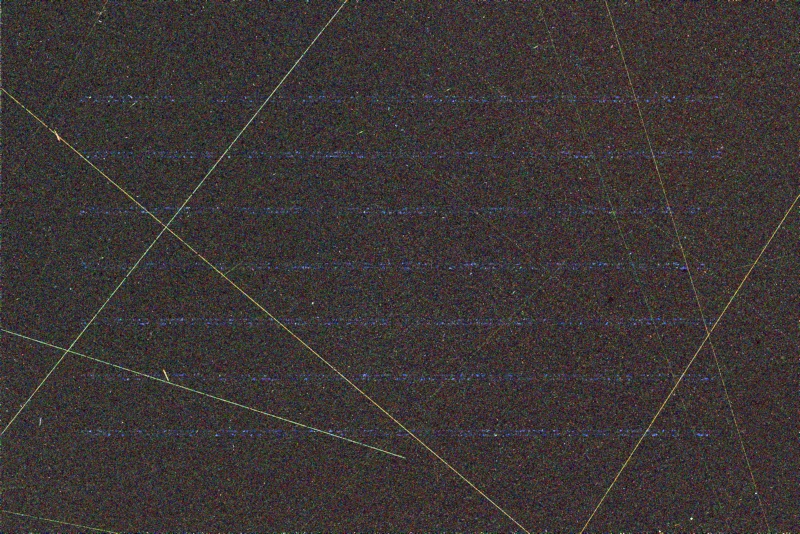The Heart and Soul nebulae (IC 1805 and IC 1848) are in Cassiopeia and are high enough above the horizon to start shooting relatively early in the evening, so I set up and shot 51 x 5 min for 255 minutes of total exposure.

| Object | IC 1805, IC 1848, NGC 1027 |
| Camera | Hap Griffin Modified Canon T6i |
| Lens/Scope | William Optics RedCat 51, 250mm FL, f/4.9 |
| Exposure | 255 minutes (51 x 5 min) @ ISO 800 |
| Location | Cherry Springs State Park, PA |
| Processing | PixInsight for calibration and initial histogram adjustment PWP8 for additional color and histogram adjustments |
The longer exposure made processing this much easier. The signal-to-noise ratio is way better, fainter parts of the nebula don’t fall apart and become grainy when I do the contrast enhancement.
My first impression was that there are too many stars compared to all the images I’ve seen online. But then I found this comparison, by Trevor Jones who runs the AstroBackyard YouTube Channel. He shows an image from a modified DSLR (similar to mine) and another using an H-alpha filter. The latter shows fewer stars. And most of the images I’ve found online are done with narrow-band filters which allow specific wavelengths from ionized gas clouds, but little starlight. So yeah, there are really that many stars in the field.
Here’s a bit of fun on what PixInsight is doing under the hood when I ask it to do the integration of those 51 frame but to also do pixel-level statistical rejections.

Those long lines crossing the frame are satellite trails. If I walk through the frames one-by-one, I can spot a couple of the brighter ones (the above image has been severely stretched). Additionally, there are two small lines that look suspiciously like faint meteor trails that were also removed. THe horizontal banding is something I need to look into more, but that appears to be structure in the DSLR sensor itself that calibrations failed to remove. I can see similar banding in the master bias frame. I suspect the issue is that because the camera temperature floats with the environment, that the darks and lights don’t quite match leaving the above residual banding.
Written by Roland Roberts
Search
.Archives
- May 2025 (1)
- October 2024 (1)
- May 2024 (2)
- April 2024 (3)
- September 2022 (5)
- April 2022 (1)
- January 2022 (3)
- December 2021 (4)
- September 2021 (3)
- July 2021 (1)
- January 2021 (1)
- November 2020 (2)
- October 2020 (2)
- September 2020 (2)
- August 2020 (5)
- July 2020 (1)
- November 2019 (2)
- September 2019 (1)
- August 2019 (2)
- September 2017 (1)
- August 2017 (1)
- September 2015 (3)
- August 2015 (2)
- June 2015 (5)
- May 2015 (3)
- May 2013 (2)
- January 2013 (1)
- December 2012 (2)
- September 2012 (1)
- June 2012 (1)
- May 2012 (1)
- October 2011 (2)
- September 2011 (2)
- April 2011 (2)
- March 2011 (10)
- January 2011 (8)
- November 2010 (2)
- October 2010 (1)
- September 2010 (3)
- August 2010 (2)
- July 2010 (1)
- June 2010 (1)
- April 2010 (3)
- February 2010 (3)
- January 2010 (3)
- December 2009 (6)
- November 2009 (3)
- October 2009 (7)
- September 2009 (8)
- August 2009 (4)
- July 2009 (1)
- June 2009 (2)
- May 2009 (2)
- April 2009 (7)
- March 2009 (1)
- February 2009 (6)
- January 2009 (4)
- December 2008 (4)
- November 2008 (3)
- October 2008 (11)
- September 2008 (4)
- August 2008 (5)
- July 2008 (5)
- June 2008 (2)
- April 2008 (4)
- March 2008 (18)
- February 2008 (9)
- November 2007 (1)
- October 2007 (3)
- July 2007 (3)
- April 2007 (1)
- March 2007 (6)
- February 2007 (3)
- December 2006 (3)
- October 2006 (4)
- September 2006 (1)
- July 2006 (5)
- May 2006 (10)
- April 2006 (9)
